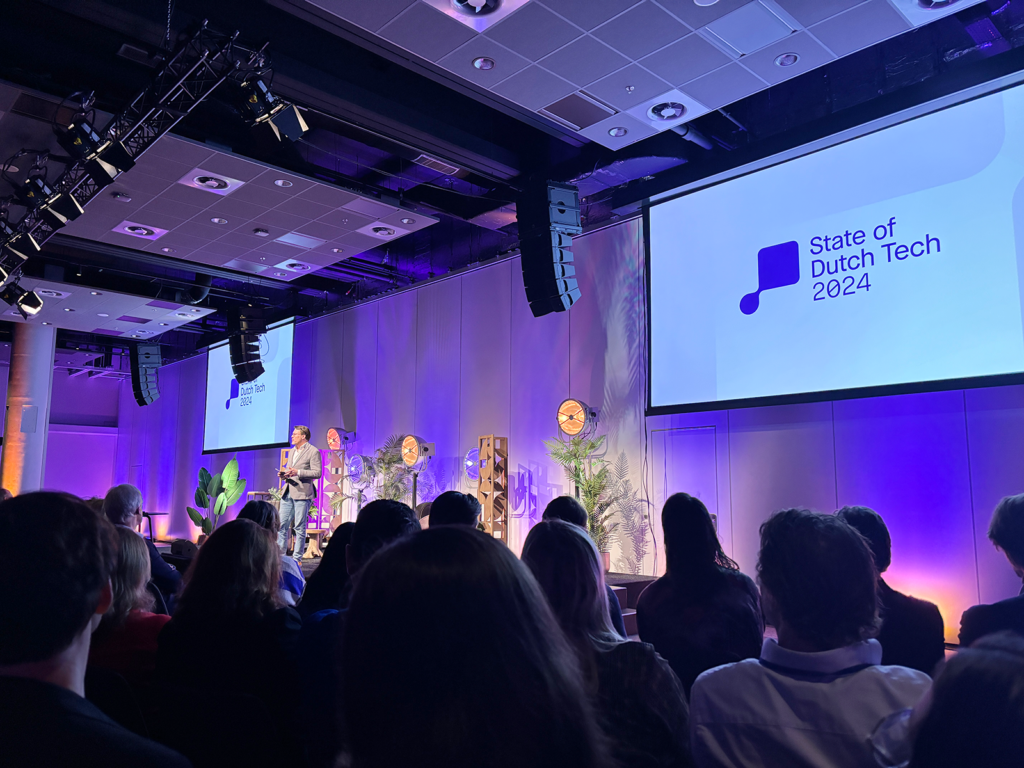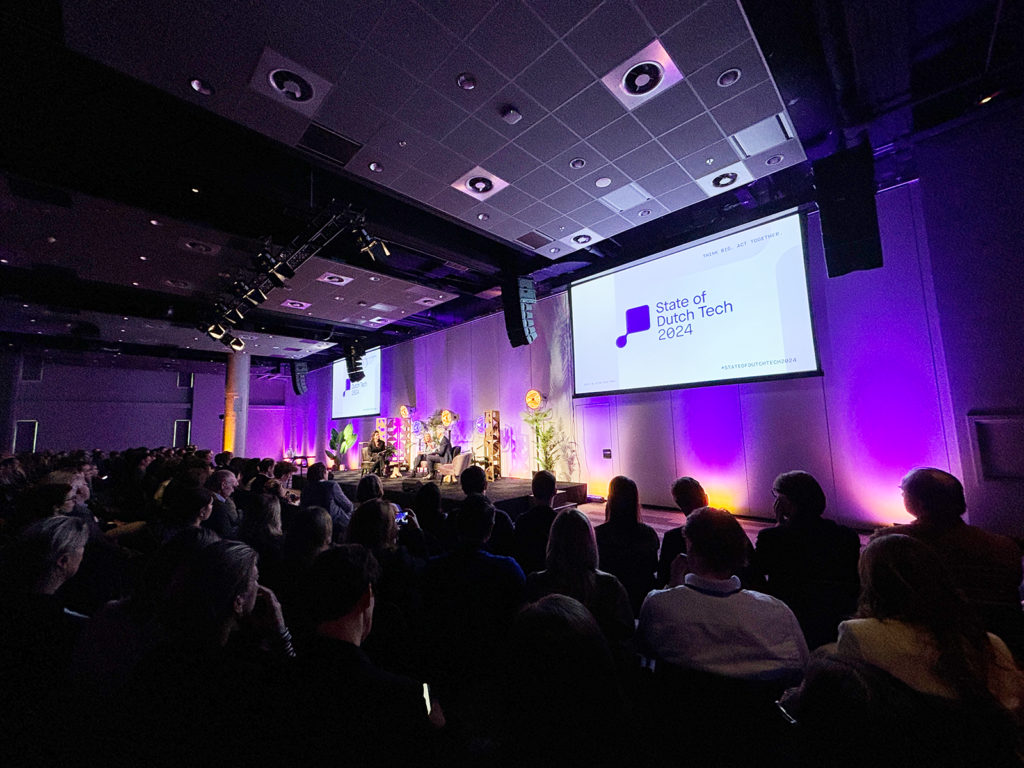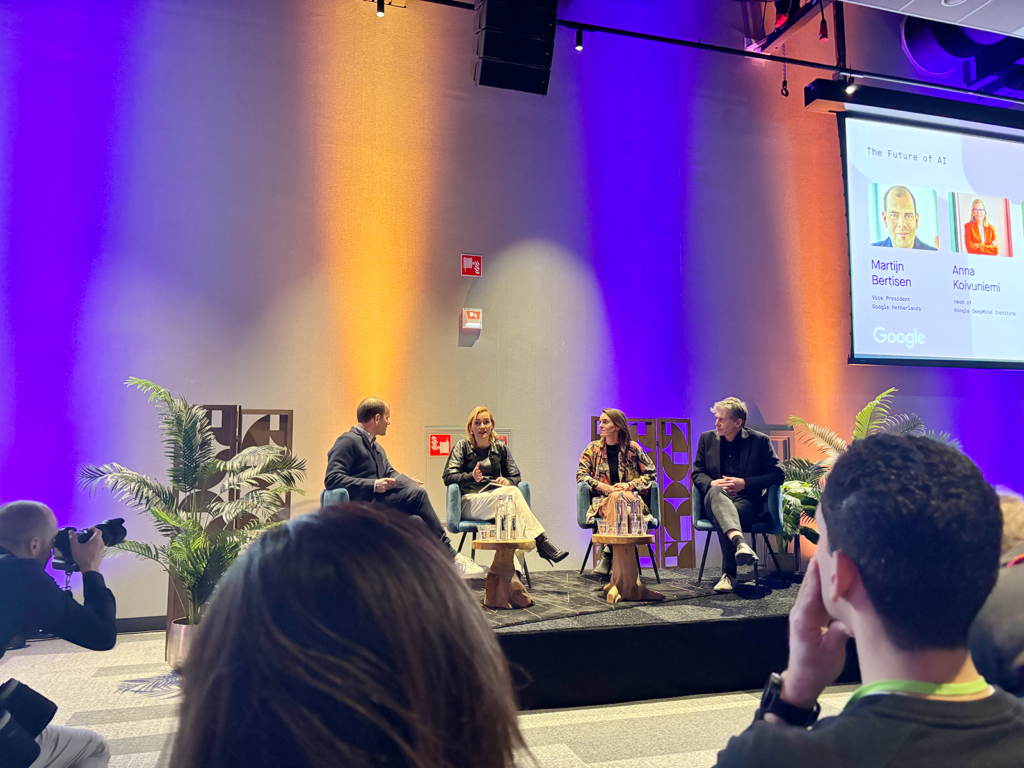
Menu
Making the Dutch tech sector thrive by focusing on talent, funding and education
“It’s not just about scaling up or reaching new heights” – a voice-over of an impressive introduction video at the State of Dutch Tech event tells us. “It’s about changing lives!” On the 6th of March thought leaders, academics, policy makers, investors and founders came together in Den Haag to discuss the state of technological innovations within the Netherlands. And Women in AI Netherlands was there to join the conversation.
Author: Ingrid van Heuven van Staereling.
How are Dutch tech companies doing?
Eva de Mol, Founding Partner at CapitalT, starts the introduction and welcomes us to the event. Eva points out that, as a tech investor, she sees the Dutch invest in technology. But at the same time, she notes that global competitors and other countries have invested significantly more. “How do we reduce the risk of solely becoming consumers of technology, versus the true producers of technology?” According to Eva, acting together is the only way to go forward. And she claims the State of Dutch Tech report that will be launched will give us a lot of ideas for action. So today we are promised a deep dive into the Dutch business climate by addressing its challenges and opportunities.

Eva explains about the importance of the discussions that will take place today, especially the one between Micky Adriaansens (Minister of Economic Affairs and Climate Policy of the Netherlands) and Peter Wennink (CEO of ASML). She says it is about “Hearing both from governmental perspective and the reality of the business climate.” Doing business in the Netherlands as a tech company is not always appealing. Earlier that day the Dutch government announced it is deploying an operation called ‘Beethoven’. This is ment to keep leading tech companies, with the emphasis on ASML, in the Netherlands. There are concerns that the chip machine manufacturer will leave the Dutch business climate. Due to the lack of technically skilled workers in the Netherlands, the company is largely dependent on migrant workers. The company fears that the rules for migrant workers will be further restricted
The current state of the Dutch tech
We are giving a lookback at the Dutch tech sector of 2023, which is definitely one of the strongest in Europe. The big worry is that it is slowing down. A new video tells us there are no billion dollar companies for the past two years. Funds is a big issue, since a majority of the Dutch tech companies don’t succeed in raising funds after the initial seed investment. And while there are a good number of deeptech companies coming out of universities or knowledge institutes, startups in the Netherlands have the slowest growth rate of the top countries in Europe. Finding skilled people is hard and the Netherlands is very dependent on international talent. Constantijn van Oranje, Special Envoy at Techleap, also addresses the issue: “We need to have more specialists in the Netherlands. To stay innovative and relevant.” When it comes to making this talent interested in working here, compensation is the leading challenge. Along with the gender pay gap and the continuing inequality, the report tells us. These are the problems we, at Women in AI, are very much aware of. But how do you solve them?
"We need to look at where we can create the most value.”
The business climate of the Netherlands
“We are not doing a bad job.” Micky Adriaansens, Minister of Economic Affairs and Climate Policy of the Netherlands, tells the audience. “But I think we have to do more, and we have to be more vocal about the challenges that we are facing.” Peter Wennink, CEO of ASML, wonders if we have an environment that is supportive to growth. “We would not have existed today, if the government hadn’t funded us many years ago.” He explains that this funding had given the company the best opportunity to grow and develop. But this was based on a different type of ecosystem, Peter explains: “People collaborated. The idea was to be very transparent to each other and to fairly share the risks and rewards of this dream.” He believes that this is what builded the company to where it is now.
Peter is worried that some of the elements that helped ASML are now under pressure. But he is also aware of the fact that you can’t just look at the government and say ‘solve our problem’. That is why he and his company try to help solve some of the problems themselves, like the search for talent. They invest in education and try to get kids excited about science. When talking about what to invest in Peter realizes that there are massive societal challenges at the moment. “So we need to look at where we can create the most value.” This is one of his main concerns.

The practical use of AI
Artificial Intelligence plays a big part of the conversations at the event. Is the Netherlands doing enough when it comes to AI? During the afternoon panel session ‘The Future of AI’ all aspects about applying this technology come to mind. Martijn Bertisen, Vice President at Google Netherlands, opens the panel session with a video that shows us what AI is already doing for us right now. He explains the effect it can have on people’s lives to have access to this technology, like being able to take selfies when you have a vision impairment. Using AI technology goes beyond creating opportunities for the economic world. “With AI we can tackle some of the biggest challenges we are facing as humanity.” Google is very much an AI first company and they were (and still are) at the epicenter of a lot of AI developments. “But that also makes you part of the responsibilities that come with that.” – Martijn explains. And he admits it is incredibly hard to get this right, hinting to the Gemini struggles they have recently been facing. “But we are committed to getting it right, to learn from it and do better.”

The panel consists of people from various markets, like healthcare and bioengineering. This way we get a glimpse into what practical ways AI is used right now and what the future will hold for these markets. Anna Koivuniemi, Head of Google DeepMind Institute, also joins the conversation. In her experience the possibilities of AI are endless: “If a machine is given a problem it will find creative ways to solve it.” At the Princess Maxima Center they use AI on a regular basis. Michiel Kooper is a CIO at the center and explains how they use it in finding the right treatment for the children that are in the hospital there. “We want to speed up what we do when we treat the children, and AI helps us to find what treatment would be best to use.” Helping to speed up processes is one of the biggest advantages of using AI. Elise de Reus, Co-founder at Cradle, can relate to that. They have found a way they can research the structure of proteins quicker. This used to take up a lot of time to investigate, but with the help of AI they can run it in approximately 15 minutes. That way it doesn’t take a lot of time for a scientist (or scientists) that does tests in a lab, it only takes one big model that has been trained to speak that language. “With the help of AI they were able to find an enzyme that can break up plastic within a week.” – Elise says.
“Understanding what can go wrong and the implication of how to interact with machines.”
The use and value of data
AI can’t exist without data. And yes, you can get the data by doing research, but this often takes a long time. AI can do that quicker, but in order to do that we need data. “If you make data accessible, you can speed up a lot of processes and find solutions faster.” Anna points out. While Elise agrees, she also is very much aware of the limitations. “AI cannot solve everything.” – she says. “And how do we make sure we collect data that actually supports the model?” Here the human factor comes to mind. User-experience research helpt to find the concerns users may have. “What do the ones working with these models need to understand about the technology to trust it and be willing to work with it?” She believes you also need to put it in the hands of the people that are doing the work. “I see a lot of excitement from computer scientists that consider biology to want to get into this field. And at the same time biologists on their part want to get into the field of computer science too.” This type of curiosity about the fields from both sides is very important.
We learn that even using the word ‘data’ can be a hurdle to overcome. “Our healthcare teams are people people.” -Michiel explains. At the center they need to rephrase it when sharing an internal item about data. The word ‘data’ in titles makes the readers skip their news items. But in general it is a good idea to give people a better understanding of what data is. But how do you do that? Michiel has good advice: “Focus on what the data models are doing, what the value of the data is.” Anna agrees it comes down to the basics of what data and the technology that is using it is. “Understanding a machine is not human, knowing it is just about giving a task.” In addition to that she believes it is important to teach about responsibility.
It is clear that many societal problems can be solved (quicker) with the help of AI. But at the same time there are limits to what AI can do and a human touch is very much needed. If we look at what has been discussed during the State of Dutch Tech, a lot of skilled talent is still very much wanted to help develop the solutions of the future. And education is the best way to make sure that these solutions are built for the right reasons.